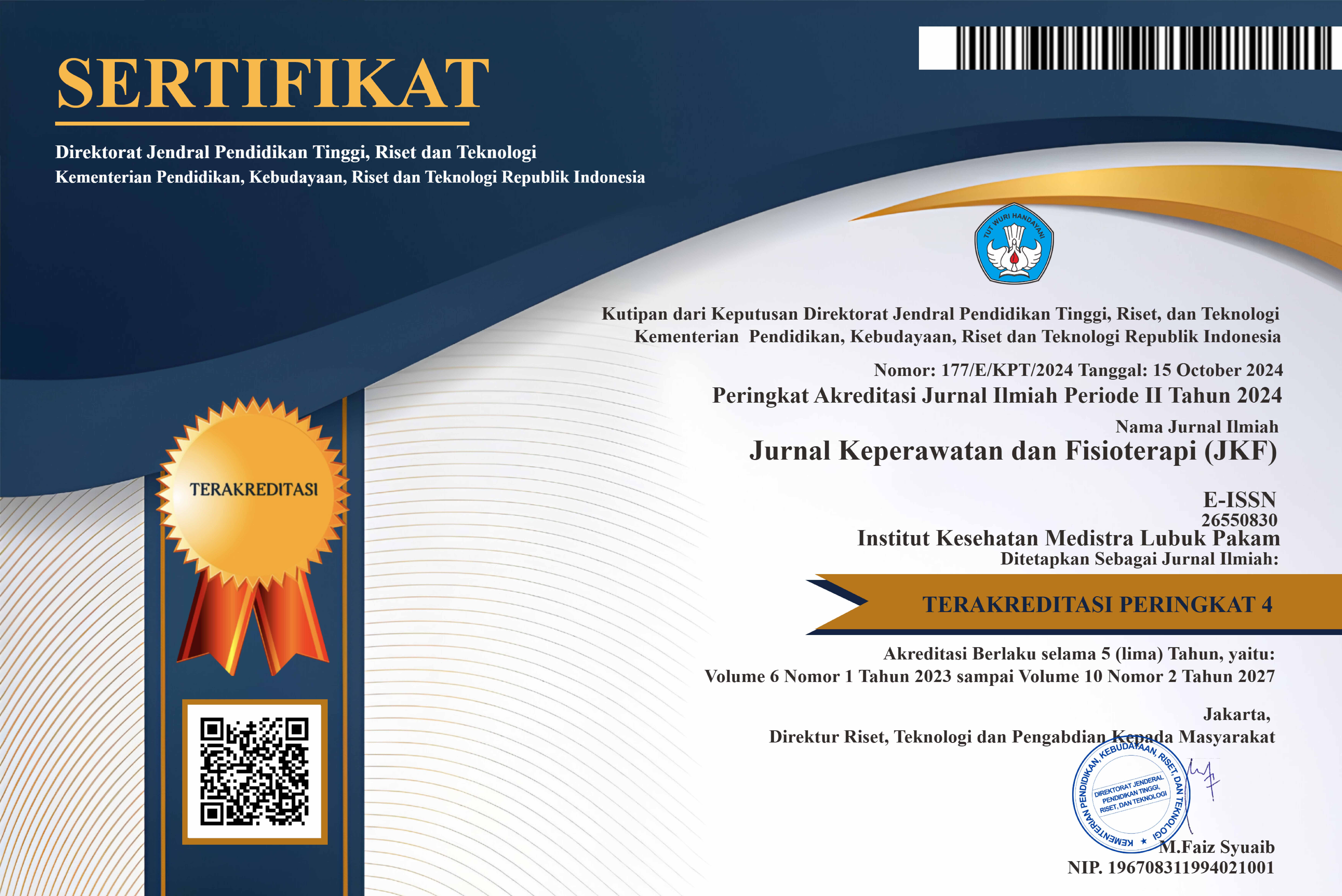The Effect of Giving Hot-Packs on The Grade of Shivering in Post-Surgery Caesarean Section Patients at Grandmed Hospital Lubuk Pakam
DOI:
https://doi.org/10.35451/jkf.v7i1.2339Keywords:
Grade shivering, Hot-Pack, Post Cesarean of Section OperationAbstract
Shivering after anesthesia is a recovery mechanism in the body due to negative side effects such as discomfort and pain due to stretching of the surgical scar, and increased muscle activity following increased oxygen demand. When a client experiences shivering, it is necessary to warm the body with heat therapy given to clients whose temperature is ? 36?C. A hot-pack is a closed package containing gel with a temperature of 40?C. The hot-pack will be given on the right and left inner arms for about 15 minutes. The type of research used is pre-experimental with one group Pre-test and Post-test design. The technique used in sampling in this study is non-probability sampling, in the form of Accidental sampling with a sample size of 20 respondents, while the instrument used in this study is an observation sheet. This study uses univariate and bivariate analysis. In this study, bivariate analysis was carried out using the Paired T-Test. Based on the Statistical Test conducted using the Paired Sample T-test method, the value obtained was p value 0.000 (? <0.05) which means Ho is rejected and Ha is accepted. This means that there is an Effect of Giving Hot-Packs on the Degree of Shivering in Post-Caesarean Section Patients at Grandmed Hospital Lubuk Pakam. This study concludes that giving hot-packs reacts to skin receptors and channels the temperature effect on body heat so that it can reduce shivering.
Downloads
References
Supartiningsih, S. 2017. Kualitas Pelayanan Kepuasan Pasien Rumah Sakit: Kasus Pada Pasien Rawat Jalan. Jurnal Medicoeticolegal dan Manajemen Rumah Sakit, 6(1), pp.9-15.
Tri, A. M., & Nikein, S. (2019). Teiknik Reilaksasi Nafas Dalam Untuk Meinurunkan Skala Nyeiri Pada Pasiein Post Opeirasi Seictio Caeisareia. Jurnal Manajeimein Asuhan Keipeirawatan, 3(2), 19–25. https://doi.org/10.33655/mak.v3i2.70
Fitri, A., & Sinar, R. (2019). Pengaruh Pemberian Hot-Pack Terhadap Grade Shivering Pada Pasien Post Operasi Seksio Sesaria Di Recovery Room Rumah Sakit Siti Khodijah Muhammadiyah Cabang Sepanjang.
Kosanke, R. (2019). Asuhan Keperawatan Pasien Post SC. Jurnal Keperawatan Terpadu, 5–34. (Hijratun)
Yanti, D. A. M., Anggraini, S., & Yatmi, S. (2021). Hubungan Teiknik Steiril Peirawatan Luka Deingan Infeiksi Post Opeirasi Seiksio Seisareia. Jurnal Keiseihatan Panca Bhakti Lampung, 9(2), 82–91. https://doi.org/10.47218/jkpbl.v9iNo
Purba, A., Anggorowati, A., Sujianto, U., & Muniroh, M. (2021). Penurunan Nyeri Post Sectio Caesarea Melalui Teknik Relaksasi Benson dan Natural Sounds Berbasis Audio Visual. Jurnal Keperawatan Silampari, 4(2), 425–432. https://doi.org/10.31539/jks.v4i2.1808
Ramadhanti, N. A., Juniartati, Ei., Barlia, G., Suhariyanto, & Agustina, M. (2022). Asuhan Keipeirawatan pada Pasiein Post Opeirasi Seictio Caeisareia deingan indikasi Partus Lama: Studi Kasus. Jurnal Keipeirawatan Mandira Ceindikia, 1(1), 100–107.
Rante, D., Novitasari, D., & Utami, T. (2022). Gambaran Shivering pada Pasien Sectio Caesarea Post Spinal Anestesi Pemberian Levica. Snppkm 7(2013), 293–305. https://prosiding.uhb.ac.id/index.php/SNPPKM/article/view/1062%0Ahttps://prosiding.uhb.ac.i d/index.php/SNPPKM/article/download/1062/3 55.
Wulandari, Y., Kep, S., & Ms, N. (2019). Abstract Effect Of Hot-Pack Treatment To Improve Shivering Grade In Post-Operative Caesarean- Section Patients In Recovery Room At Rs Siti Khodijah Muhammadiyah Cabang Sepanjang.
Cahyawati F.E, Rohmah F, Gunadi A., Aprilia S. (2019). Cairan Intravena Hangat Terhadap Derajat Menggigil Pasien Post Sectio Caesarea Di Rs Pku Muhammadiyah Gamping. Jurnal Kebidanan, 8 (2), 2019, 86-93. Tersedia di http://jurnal.unimus.ac.id/index.php/jur_bid/
Shaw, C. A. et al. (2017). ‘Effectiveness of active and passive warming for the prevention of inadvertent hypothermia in patients receiving neuraxial anesthesia: A systematic review and meta-analysis of randomized controlled trials’, Journal of Clinical Anesthesia, 38(1), pp. 93–104. doi: 10.1038/nrg3575.Systems.
Amirullah. (2015). Populasi dan Sampel (67) dalam buku Metode Penelitian Manajemen. Malang: Bayumedia Publishing.
Suswita, D. (2019). Efektifitas Penggunaan Electric blanket pada Pasien Yang Mengalami Hipotermi Post Operasi Di Instalasi Bedah Sentral (Ibs) Rumah Sakit Umum Daerah Palembang Bari Tahun 2018. Jurnal Ilmiah Kesehatan, 8(1), 48–56. https://doi.org/10.35952/jik.v8i1.137
Advernesia. (2017). “Cara Uji Paired Sample T Test dengan SPSS dan Contohnya”. Diambil dari https://www.advernesia.com/blog/spss/cara-ujipaired-sample-t-test-dengan-spss-dan-contohnya/, pada tanggal 22 Mei 2019
Fauzi, N. A., Rahimah, S. B. and Yulianti, A. B. (2015). ‘Gambaran Kejadian Menggigil (Shivering) pada Pasien dengan Tindakan Operasi yang Menggunakan Anastesi Spinal di RSUD Karawang Periode Juni 2014’. Karya Ilmiah UNISBA.
Tewari, A. et al. (2014). ‘A comparative study evaluating the prophylactic efficacy of oral clonidine and tramadol for perioperative shivering in geriatric patients undergoing transurethral resection of prostate.’, Journal of anaesthesiology, clinical pharmacology. Wolters Kluwer -- Medknow Publications, 30(3), pp. 340– 4. doi: 10.4103/0970-9185.137264.
Zaman, S. S., Rahmani, F., Majedi, M. A., Roshani, D., & Valiee, S. (2018). A Clinical Trial Of The Effect Of Warm Intravenous Fluids On Core Temperature And Shivering In Patients Undergoing Abdominal Surgery. Journal of Perianesthesia Nursing, 33(5), 616–625. https://doi.org/10.1016/j.jopan.2016.12.010
Downloads
Published
Issue
Section
License
Copyright (c) 2024 Arfah May Syara, Syatriawati

This work is licensed under a Creative Commons Attribution 4.0 International License.
Copyright in each article is the property of the Author.


























